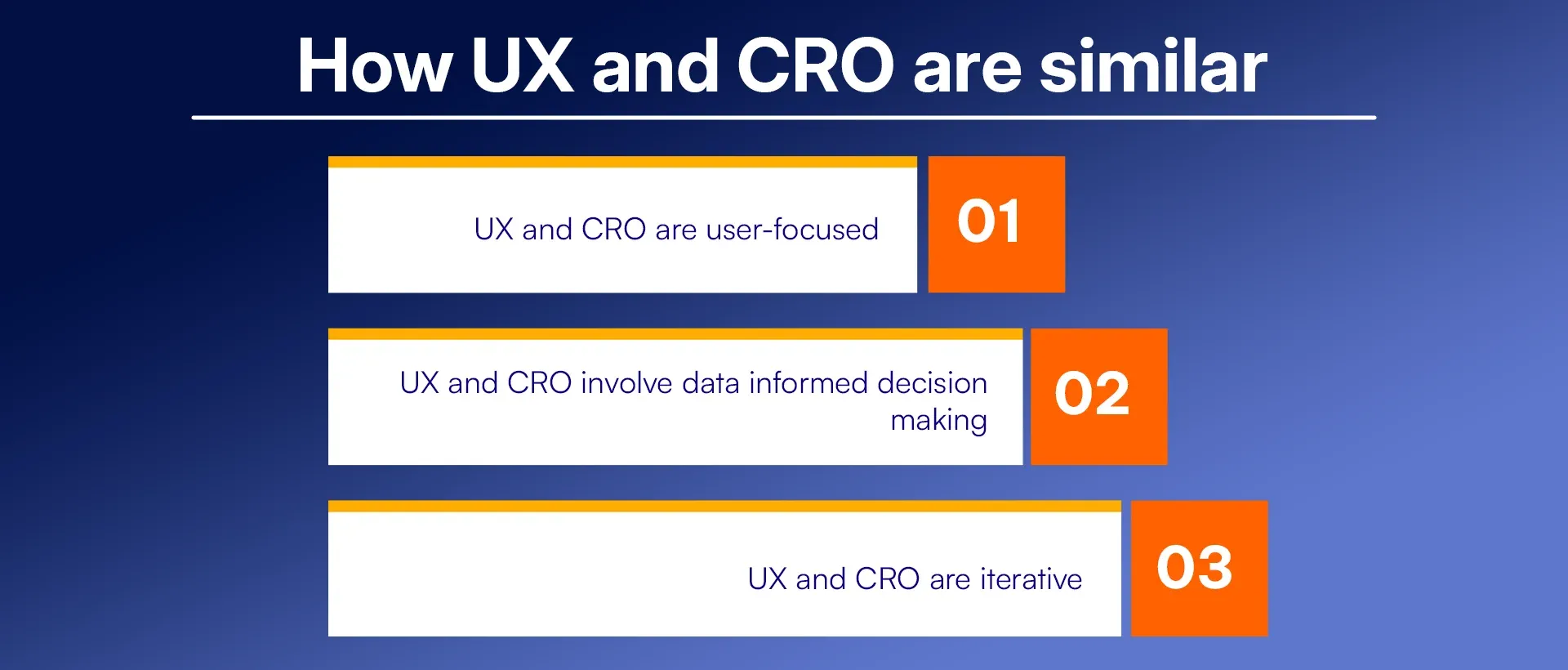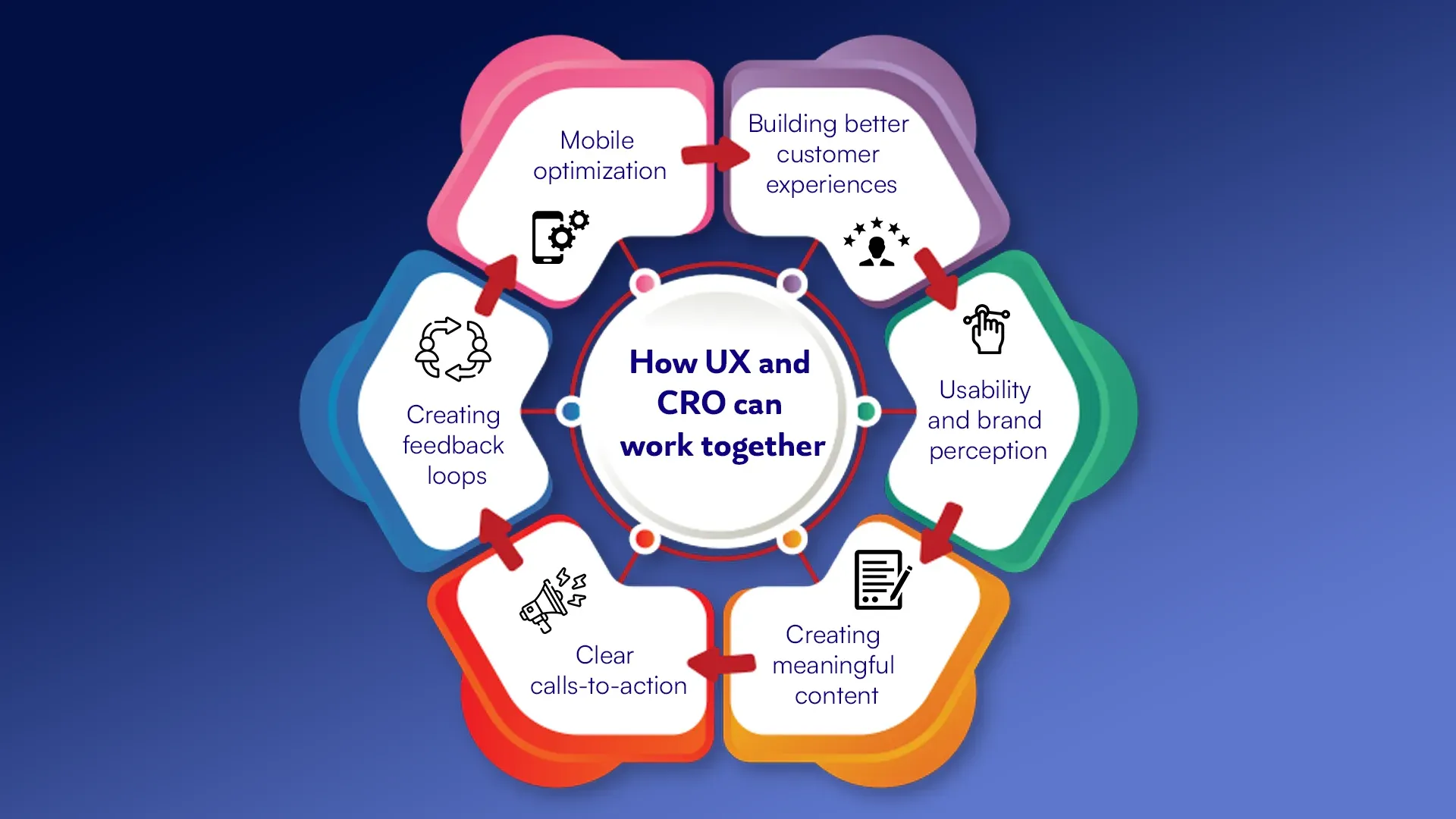
Most businesses today have their own website or app. It's because it offers convenience to users and helps with building brand loyalty.
And every business is focused on two things. First is providing a seamless user experience and second is optimizing conversions.
Since there are so many competitors out there, you have to stand out. How can you do it? By providing a seamless user experience.
But is it enough? No, right!
You are gonna need some way to generate revenue for your business. So, what you can do about it?
Optimize it for better conversions.
But before you get into all of these, it is important to understand what is UI/UX, and CRO and how they are different.
In this article, we’ll cover,
What is UI/UX? What is CRO? How does CRO UX work together? What are the differences between them?
What is UI/UX?
We often use the term UI/UX together but both focus on different aspects. Though you can build apps when you get both right.
UI mostly involves designing visual and interactive elements on a site or app. It includes many things like buttons, layouts, colors and more. The core focus of UI is to build platforms that are visually appealing.
On the other end, UX focuses more on experience. It includes, user journey, how they feel using the platform, how easy it is to navigate, and more.
What is Conversion Rate Optimization (CRO)?
CRO means optimizing your site for better conversions. Just think about it, if you have good traffic and you are not getting conversions, there is something you have to improve. You can not keep spending more money to get more customers, if your conversions are low. That is where CRO helps.
And by conversion, it doesn’t mean the user is paying for your service. It can be anything like sign up, clicking the button or more.
CRO is more focused on understanding where users face hurdles, and how to optimize the journey so the user takes a desired action.
How UX and CRO are Similar
Both UX and CRO are focused on user, data and iteration, CRO UXCRO stands for the same. They aim to understand user needs, test improvements, and adapt based on feedback, continuously refining the experience and journey to meet evolving expectations.

1. UX and CRO Are User-Focused
Both UX and CRO are focused on the user. UX helps you deliver a better experience. And CRO helps you make the process smooth, so users can take certain actions.
2. UX and CRO Involve Data-Informed Decision Making
Both UX and CRO use data for making decisions. UX designers use feedback from users to improvise design and CRO uses data to find barriers in user journey.
3. UX and CRO Are Iterative
Both UX and CRO is not a one time process. You have to regularly optimize it based on feedback. It requires testing and analyzing different aspects and making improvements based on that.
How UX and CRO Can Work Together?
UX and CRO is something that can work separately. They have to work together because it's good for business. Though both work on different aspects, they both have the same goal - to help users get what they want. Here we have listed some benefits that you get when they work together.

1. Building Better Customer Experiences
With UX and CRO combined, the experience is more tailored and enjoyable. UX ensures users feel valued, while CRO optimizes the experience for maximum engagement. Together, they enhance satisfaction and drive business goals.
2. Usability and Brand Perception
Your product usability is one of the key pointers that reflects your brand. UX focuses on making your platform easy to use and CRO makes sure that the end user gets the information that they need to make decisions quickly. So combining them can help you build brand loyalty.
3. Creating Meaningful Content
Content plays a vital role in both UX and CRO. UX designs content that aligns with user needs, and CRO optimizes it for action. By working together, they create content that resonates and leads to meaningful actions.
4. Clear Calls-to-Action (CTAs)
Effective CTAs bridge UX and CRO. UX ensures that CTAs are placed intuitively, while CRO designs them to be persuasive and action-driven. Together, they guide users through a seamless journey toward conversion.
5. Creating Feedback Loops
Feedback is key to both UX and CRO improvement. UX relies on user feedback to refine the experience, while CRO looks at conversion data to test new strategies. They both feed into each other, continuously enhancing user satisfaction and conversion rates.
6. Mobile Optimization
In a mobile-first world, UX and CRO must consider mobile optimization. UX designs for responsive usability, while CRO tests for mobile-specific conversions.
What Are the Differences Between UX and CRO?
UX and CRO are different in some aspects. Here we have listed some aspects, so you can see the clear difference between each of them.

1. Focus
The focus of UX is to improve the entire user journey and make sure that every interaction feels intuitive. On the other end, CRO is more focused on increasing conversion. It encourages users to complete a certain action.
2. Goals
The primary goal of UX is providing a seamless experience. It helps keep the users engaged and satisfied. On the other hand CRO focuses on increasing the number of users taking a specific action. It reduces the friction and helps improve the overall journey.
3. Elements
UX design involves elements like layout, navigation, visual appeal, and overall usability. CRO focuses on conversion related metrics like CTA buttons, forms and checkout process.
4. Approach
In UX, the approach is mostly empathy driven. It prioritizes understanding the user needs to make decisions. CRO, on the other hand, is more dependent on data. It involved techniques like A/B testing and analytics to figure out which one gives you the most conversions.
5. Timeframe
Both UX and CRO is an ongoing process. But in UX, the timeframe for changes is longer. On the other hand, CRO focuses on improving conversion rate quickly, so the timeframe for changes is shorter.
6. Metrics
In UX, the focus is on metrics like time spent, bounce rates and more. But for CRO, the metric is CTR, conversion rates and more.
7. Testing
In UX most of the testing is done on the user end by surveys and feedback. Some tools are also used for monitoring user actions. But in CRO, most of the strategies are based on data. Marketers test using A/B testing, use heat maps and track clicks to get higher conversions.
8. Scope
UX has a broad scope, and impacts the overall user experience. While CRO focuses more on specific elements like steps in the user journey to improve conversions.
| Aspect | UX | CRO |
|---|---|---|
| Focus | Enhancing the user’s overall journey and satisfaction | Increasing the rate of conversions from user actions |
| Goals | User enjoyment, ease of use, satisfaction | Maximizing conversions, minimizing friction |
| Elements | Usability, layout, navigation, visual appeal | CTAs, forms, checkout processes, user flow optimization |
| Approach | Empathy-driven design, feedback loops | Data-driven testing, A/B testing, analytics |
| Timeframe | Continuous, evolving as user needs change | Targeted, focused on specific conversions |
| Metrics | Time on site, bounce rate, task completion | Conversion rate, click-through rate, form submission rate |
| Testing | Usability tests, surveys, user feedback | A/B testing, heatmaps, click tracking |
| Scope | Holistic, affecting the entire experience | Specific, focused on elements leading to conversions |
Conclusion
So, now you know why focusing on both UI/UX and CRO is important for your business. If you are stuck, get professional help from industry experts at Rejoicehub. We provide UI/UX services for modern businesses. We have a team of professional designers who are expert in creating conversion friendly platforms.
Frequently Asked Questions
1. How can UX and CRO work together to improve conversions?
UX enhances the journey’s quality, while CRO optimizes touchpoints to encourage actions. Both of them together can help you deliver a seamless experience. Also, it will improve conversions.
2. What’s the main difference between UX and CRO?
UX improves overall user satisfaction. On the other hand, CRO focuses on maximizing conversions. UX is holistic, and CRO targets specific actions for business gains.
3. Why are UX and CRO considered iterative processes?
Both rely on ongoing testing and feedback to adapt and improve. This ensures they align with evolving user needs and business goals.
